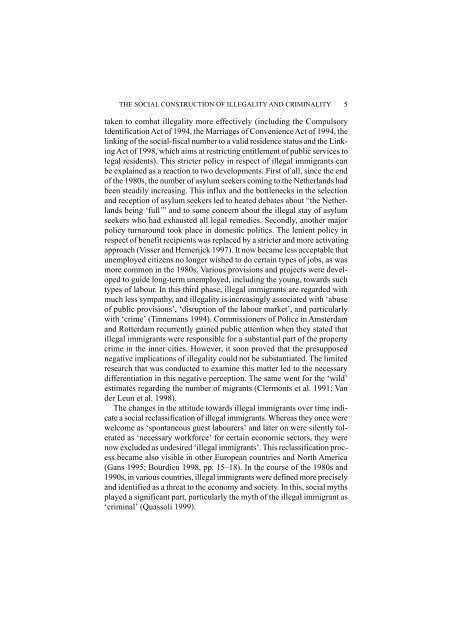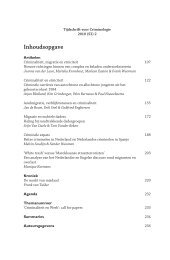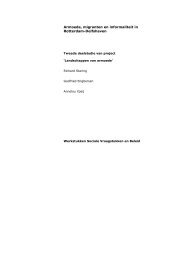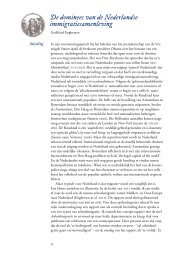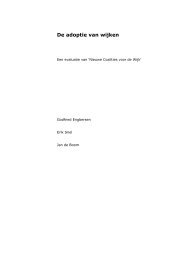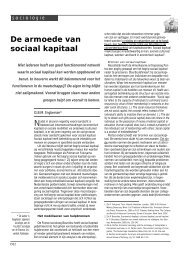THE SOCIAL CONSTRUCTION OF ILLEGALITY AND CRIMINALITY ...
THE SOCIAL CONSTRUCTION OF ILLEGALITY AND CRIMINALITY ...
THE SOCIAL CONSTRUCTION OF ILLEGALITY AND CRIMINALITY ...
You also want an ePaper? Increase the reach of your titles
YUMPU automatically turns print PDFs into web optimized ePapers that Google loves.
<strong>THE</strong> <strong>SOCIAL</strong> <strong>CONSTRUCTION</strong> <strong>OF</strong> <strong>ILLEGALITY</strong> <strong>AND</strong> <strong>CRIMINALITY</strong> 5<br />
taken to combat illegality more effectively (including the Compulsory<br />
Identification Act of 1994, the Marriages of Convenience Act of 1994, the<br />
linking of the social-fiscal number to a valid residence status and the Linking<br />
Act of 1998, which aims at restricting entitlement of public services to<br />
legal residents). This stricter policy in respect of illegal immigrants can<br />
be explained as a reaction to two developments. First of all, since the end<br />
of the 1980s, the number of asylum seekers coming to the Netherlands had<br />
been steadily increasing. This influx and the bottlenecks in the selection<br />
and reception of asylum seekers led to heated debates about “the Netherlands<br />
being ‘full’” and to some concern about the illegal stay of asylum<br />
seekers who had exhausted all legal remedies. Secondly, another major<br />
policy turnaround took place in domestic politics. The lenient policy in<br />
respect of benefit recipients was replaced by a stricter and more activating<br />
approach (Visser and Hemerijck 1997). It now became less acceptable that<br />
unemployed citizens no longer wished to do certain types of jobs, as was<br />
more common in the 1980s. Various provisions and projects were developed<br />
to guide long-term unemployed, including the young, towards such<br />
types of labour. In this third phase, illegal immigrants are regarded with<br />
much less sympathy, and illegality is increasingly associated with ‘abuse<br />
of public provisions’, ‘disruption of the labour market’, and particularly<br />
with ‘crime’ (Tinnemans 1994). Commissioners of Police in Amsterdam<br />
and Rotterdam recurrently gained public attention when they stated that<br />
illegal immigrants were responsible for a substantial part of the property<br />
crime in the inner cities. However, it soon proved that the presupposed<br />
negative implications of illegality could not be substantiated. The limited<br />
research that was conducted to examine this matter led to the necessary<br />
differentiation in this negative perception. The same went for the ‘wild’<br />
estimates regarding the number of migrants (Clermonts et al. 1991; Van<br />
der Leun et al. 1998).<br />
The changes in the attitude towards illegal immigrants over time indicate<br />
a social reclassification of illegal immigrants. Whereas they once were<br />
welcome as ‘spontaneous guest labourers’ and later on were silently tolerated<br />
as ‘necessary workforce’ for certain economic sectors, they were<br />
now excluded as undesired ‘illegal immigrants’. This reclassification process<br />
became also visible in other European countries and North America<br />
(Gans 1995; Bourdieu 1998, pp. 15–18). In the course of the 1980s and<br />
1990s, in various countries, illegal immigrants were defined more precisely<br />
and identified as a threat to the economy and society. In this, social myths<br />
played a significant part, particularly the myth of the illegal immigrant as<br />
‘criminal’ (Quassoli 1999).


